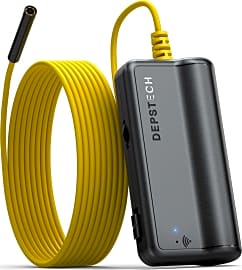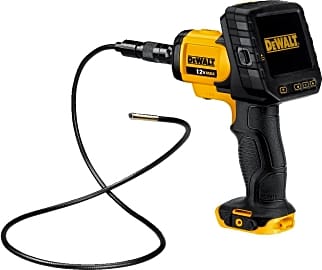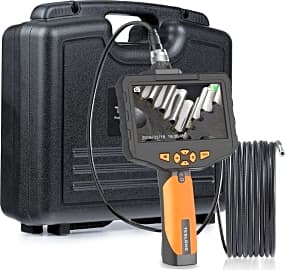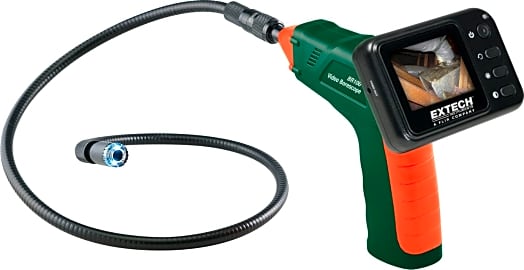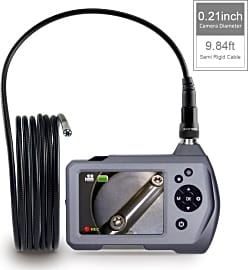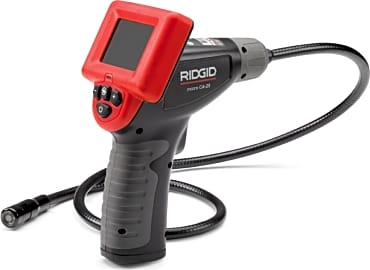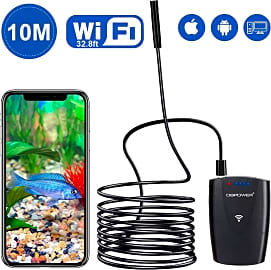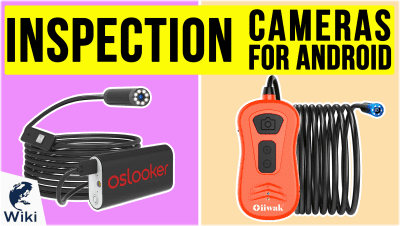The 10 Best Inspection Cameras

This wiki has been updated 42 times since it was first published in April of 2015. When you have to find the source of trouble in a hard to reach location, like behind a wall, or in an air duct, pipe, or vehicle's engine, an inspection camera can be invaluable. Our comprehensive selection of borescopes (or boroscopes, if you prefer) includes high-tech models that can capture, and often record, still images and videos for reviewing in real-time or at a later date. When users buy our independently chosen editorial choices, we may earn commissions to help fund the Wiki.
Editor's Notes
September 08, 2020:
A lot of the borescopes and endoscopes on the market are starting to look more like the Depstech Borescope and the Dbpower WiFi Endoscope, which both create small Wi-Fi networks you can join with a phone or tablet to use that as your viewscreen. For a large number of consumers, this is a huge convenience, as it eliminates the need to house much extra hardware, and as most people tend to already have a phone on them anyway.
But professionals are still going to need something a little more rugged than that. For example, the Extech BR100 with its hard carrying case and IP67 waterproof rating make it an ideal companion to use in workshops and garages, or on sites where things are liable to get a little messy. Sure, that Depstech model is also rated IP67, but the phone it connects to might have a harder time holding up under adverse conditions.
Ultimately, users will want to look for a camera with good lighting, a high megapixel count, and a clear screen that's bright enough to perform in sunlight. The question of a recording ability is also a big one, especially if you're dealing with clients who want some visual proof of your claim, making this particular feature ideal for car mechanics.
August 15, 2019:
Without a ton of innovation being poured into the sector, we kept a lot of the models from our last ranking, but found it was necessary to reorganize them a bit based on how they'd performed. The Lemonbest model previously at number nine is the only offering that we felt had to go, both for performance reasons and availability problems. In its place, we looked to Teslong, whose exceedingly portable Micro option fell a bit from the fourth to the sixth spot, but whose industrial model came in swinging. That device boasts 720p resolution and a 4.3-inch screen, so it'll be hard to miss any issues under inspection.
We also found some borescopes for our special honors section, one of which may seem comically expensive at first, but you should keep in mind that it's a precision instrument designed for use in things like aircraft maintenance, where missing small details can cost lives.
Special Honors
PCE Industrial Borescope 200UV This model is noteworthy for the configuration of its tip, which combines both UV and visible spectrum light sources that can be used independently or in conjunction with one another. It also boasts cameras on the front and the sides, giving you more viewing angles to tackle a wide variety of jobs. pce-instruments.com
Gradient Lens Corporation Hawkeye V2 This is an option that's truly only suitable for professionals in incredibly demanding fields. You might see it in the hands of fighter jet technicians more readily than you would a layman, thanks to its outstanding build quality, precision ground optics, and almost comically absurd price point. gradientlens.com
Whistler WIC 4750 In addition to being water-resistant, this model can stand up to gasoline, oil, diesel, and alcohol, making it suitable for a whole host of applications, but a particularly smart choice for auto mechanics. It comes in at a pretty reasonable price for its features, as well. whistlergroup.com
Find The Cat If You Can
That's because the inspection camera is a lot like a remote controlled snake with a camera and a light attached to its head.
There's a story that gets told and retold on my dad's side of the family. It's about a day before I was born, when my grandma and her friends were all gathered around her dining room table to make rosaries as part of the charity work for their church. Suddenly, a strange thumping and scraping sound emitted from somewhere in the living room. Some of the women noticed, but went on stringing beads, not wanting to call attention to the sound.
But the sound continued, and before long all the women in the group wondered what it could be. They got up from the table and tried to locate the source of the sound. Fairly soon, they realized that it was coming from behind the wall in the front of the house.
It turns out that my grandma's cat Niki had found an open hole in the wall up in the house's attic and had made her way down among the cross braces like a feline Plinko chip.
Even having figured out that it was the cat behind the wall (it eventually stopped pawing and started mewing), determining its exact location proved to be quite difficult, and she kept moving toward different sounds within and without the house.
Eventually, they lured her out with some tuna, but the whole ordeal would have been a lot easier to handle if they'd had one of these great inspection cameras to feed into the wall.
That's because the inspection camera is a lot like a remote controlled snake with a camera and a light attached to its head. You can feed its cable through walls, under cars, into human bodies (though definitely not recommended), or anywhere else your hands and eyes could not reach.
Most of these units come with their own monitors, but you can connect a great deal of them to your smartphone or tablet, as well, for an enhanced viewing and exploring experience.
A Deeper Inspection Of The Inspectors
When you really take a close look at them, inspection cameras are pretty simple devices, especially in an age when we're so used to having high resolution cameras at out fingertips 24 hours each day.
That said, 1080 HD only requires 2 megapixels for its capture, so anything above that just increases sharpness and low-light performance.
What makes the inspection camera exceptional, though, is its reach, and that reach is the first thing you should think about when comparing devices. If you don't anticipate having a long way to snake your camera, you might be fine with a shorter cable, but having a longer run will only cost you the hassle of dealing with a little more line when you don't need it, while offering you much more reach when you do need it.
Then, of course, there's the resolution of the camera itself to consider. This is the strongest driver of price, as higher resolution and greater image quality come both from having a better sensor with more megapixels and from better lens components on the tip of the camera cable, both of which are expensive propositions.
That said, 1080 HD only requires 2 megapixels for its capture, so anything above that just increases sharpness and low-light performance.
When it comes time to view the image itself, the built-in monitors on the backs of these inspection cameras aren't usually of the highest quality. That screen is the other most expensive component of the inspection camera, and since the majority of users prefer to connect to their mobile devices for remote viewing, manufacturers don't have much reason to increase the resolution of their viewing screens.
If you're the least bit technologically impaired when it comes to tethering devices, though, you might want to invest in an inspector with a higher resolution screen on the back of it.
Nothing Boring About It
Imagine yourself at the proctologist's office. There may come a time where he advises that they take a look inside your nether regions to determine certain aspect of your health.
The process sounds uniquely uncomfortable, but it's become a medical necessity as useful as the MRI or the ultrasound.
You're going to have to fast for a couple of days, and when you return, the doctor will reach for something called an endoscope, which is a camera designed to enter the human body through a particular orifice. The process sounds uniquely uncomfortable, but it's become a medical necessity as useful as the MRI or the ultrasound.
The endoscope is a device incredibly similar to these lovely inspection cameras, though I feel like I should repeat the disclaimer that these specific tools are not meant for an amateur medical examination. Both types of camera, though, are types of borescopes, a device that's been with us only since the 1960s.
The borescope was invented by an Indian-born American physicist named Narider Kapany, and was designed along a rigid line for use in mechanical engineering more than anything else.
As camera technology got smaller and smaller, low resolution black and white cameras on flexible lines of cable gave way to the kind of high-resolution digital inspection cameras we think are so darn cool.


